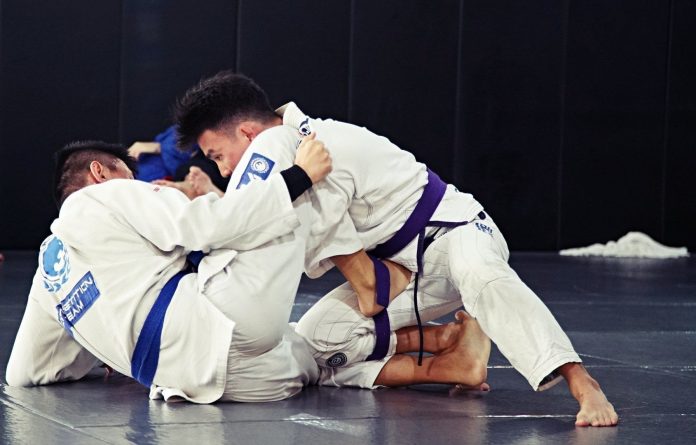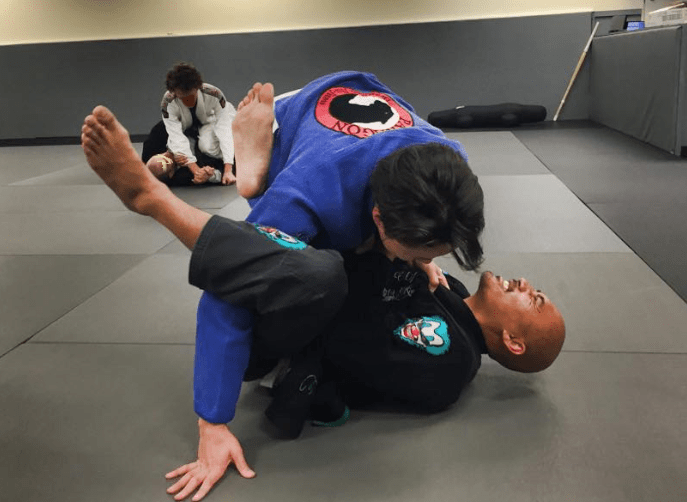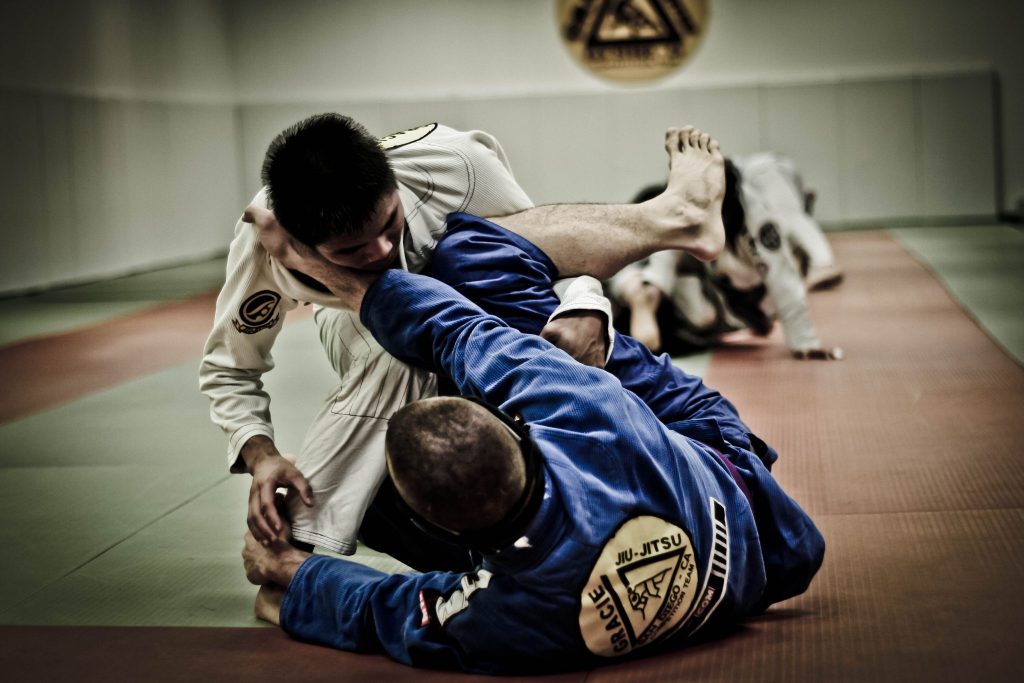
Brazilian Jiu-Jitsu is not just the Gentle Art. It is the art of balancing very technical movements within the chaos of free sparring, all the while playing chess in your mind. This balance is a huge step in Jiu-Jitsu and one that needs to be mastered by everyone involved in any kind of grappling martial arts. However, it is an extremely difficult task. Staying calm enough to look for technical nuances while rolling is kind of an oxymoron. It’s difficult enough to categorize all those Jiu-Jitsu techniques when resting, let alone apply them live. So, how does one go about to find this elusive balance of BJJ?
One approach is to roll as much as you can, with as many people as you can. It is certainly the right approach, but at a certain point, it is inevitably going to need modification. The thing is, when we roll we still look for as much control as possible, despite the environment of entropy we find ourselves in. It is human nature, to try and bring order to things, The problem that arises is that we tend to look for our favorite Jiu-Jitsu techniques during rolls and stay away from positions that are not in our top-stuff toolbox. There is, although, a method that is going to make you widen your technical arsenal while you roll.
Hard Rolls For Better Jiu-Jitsu Techniques
It is already very well established that grappling martial arts are very tiresome athletic activities. Wrestling workouts, for example, are notoriously difficult. The idea behind it is that it builds ‘mental toughness’ in grapplers. That aside, it does one more thing that is, for some reason, not recognized enough. Pushing through hard training forces grapplers to emphasize the use of techniques a lot more.
The reasoning behind this is actually very simple. The more tired you are, the less you can rely on your physical attributes. Whether you’re freakishly strong or flexible like rubber, you won’t be able to use your favorite Jiu-Jitsu techniques when exhausted. The reason most people tend to do moves that turn out high-percentage for them is certain physical attributes that allow them to do so. When these are taken away, they’re suddenly left with nothing.
Going for a roll (or 10) when tired is extremely beneficial for all levels of grapplers. Both competitors and hobbyists are going to become noticeably more technical in a short amount of time. Despite the obvious cardio gains, a huge positive is an improvement in both the quality and quantity of Jiu Jitsu techniques. Firstly, all your favorite moves are going to become way more technical than usual. Furthermore, you’re going to have to open up and utilize moves you do not use on a regular basis. When you’re in a physically disadvantageous situation, you have no other choice. One of the all-time BJJ greats, Marcelo Garcia is a big proponent of doing this and e all know what he can do!
The Correct Way To Roll Tired
There’s good reasoning behind the madness of this method. When you’re tired you’re simply unable to rely on physical strength. As a result, you’ll have to perfect whatever technique is going to get you out of a bad or into the desired position.
However, you need to be careful. Before anything else, make sure you stay safe while rolling. Don’t use the above method as an excuse to go all out until you puke. Overtraining is a real issue and can hit everyone pretty fast and hard after a short time. It’s simple, overtraining and you’ll be out for a long while. The alternative is to push through hand injure yourself seriously. Both versions of events are not acceptable for competitors, are they? Just be smart and use the ‘roll tired to learn’ approach to improve your Jiu Jitsu techniques, not to destroy yourself.
There are three main instances when you need to skip rolling altogether, let alone roll in a tired state. First and foremost, the most obvious – never roll when sick! Secondly, and again, very obviously, do not roll when injured. Actually, you should be tucked at home if your injury cannot be fixed with athletic tape. Finally, even if you have a small injury that you can roll with, skip on the rolling tired part. You’re just going to turn the small injury into a major one.
On the other hand, if you’re all healthy and simply feel tired, push yourself and go for it. Chances are you’ll tap out to people that normally cannot catch you. Chances are, you’ll be even more tired when you’re done. However, your technique will get noticeably sharper.
Practical Benefits Of Hard Rolling
The most important gain from this methodology, for BJJ, is in terms of competitive readiness. The person with the most heart often wins the division. Perseverance goes a long way, and while you can’t teach heart, you can build it. By pushing your own boundaries, you’ll build heart and the upper hand over your opponents. When you spar tired, you’ll find out where your weaknesses are and how to correct them. Rolling when rested is often going to hide your weak points by using strength where Jiu-Jitsu techniques fail.
For self-defense enthusiasts, training tired is simply a must-do. You never know when you’ll need the ability to use what you’ve learned in BJJ class after a really long day of hard work. Or even after a very hard training session, for that matter. Being physically strong is nice, but it is far better to be confident. This means knowing what you are capable of and what you are not capable of when under extreme physical stress.
Don’t push training tired to the point that you hurt yourself because then you won’t be able to train at all. That said if you train tired you will gain a deeper understanding of your own strengths and limitations. You’ll also build your heart a bit along the way. And learning the nuances of Jiu Jitsu techniques and positions will result in way better execution. In turn, this will ultimately result in more efficient energy spending – you’ll get tired less often. Now, wrap your head around that!


![Darce Choke Encyclopedia – Origins, Mechanics and Variations [2024] BJJ, choke, Brabo, BJJ Darce Choke, D'arce Choke, Darce BJJ Choke](https://bjj-world.com/wp-content/uploads/2017/11/JungPoirierLeeYahoo-218x150.jpg)










![Shotgun Aoki Locks Mateusz Szczecinski DVD Review [2025] Shotgun Aoki Locks Mateusz Szczecinski DVD Review](https://bjj-world.com/wp-content/uploads/2025/03/shotgun-aoki-locks-mateusz-szczecinski-dvd-review-218x150.png)


![Upper Body Chain Attacks Janine Mocaiber DVD Review [2025] Upper Body Chain Attacks Janine Mocaiber DVD Review](https://bjj-world.com/wp-content/uploads/2025/03/upper-body-chain-attacks-janine-mocaiber-dvd-review-218x150.png)
![The Empty Half Guard Michael Currier DVD Review [2025] The Empty Half Guard Michael Currier DVD Review](https://bjj-world.com/wp-content/uploads/2025/03/empty-half-guard-michael-currier-dvd-review-218x150.png)

![Standing Leg Entries Alex West DVD Review [2025] Standing Leg Entries Alex West DVD Review](https://bjj-world.com/wp-content/uploads/2025/03/standing-leg-entries-alex-west-dvd-review-324x235.png)
![The Bear Trap Nicolas Renier DVD Review [2025] The Bear Trap Nicolas Renier DVD Review](https://bjj-world.com/wp-content/uploads/2025/01/the-bear-trap-nicolas-renier-dvd-review-100x70.png)

![Best Marcelo Garcia Techniques by Team Marcelo Garcia DVD Review [2025] Best Marcelo Garcia Techniques by Team Marcelo Garcia DVD Review](https://bjj-world.com/wp-content/uploads/2025/02/best-marcelo-garcia-techniques-dvd-review-100x70.png)

![Reverse De La Riva System Mikey Musumeci DVD Review [2024] Reverse De La Riva System Mikey Musumeci DVD Review](https://bjj-world.com/wp-content/uploads/2024/11/reverse-de-la-riva-system-mikey-musumeci-dvd-review-100x70.png)

![Dynamic Headquarters Passing Jason Rau DVD Review [2024] Dynamic Headquarters Passing Jason Rau DVD Review](https://bjj-world.com/wp-content/uploads/2024/10/dynamic-headquarters-passing-jason-rau-dvd-review-100x70.png)

![The Rack Kyle Watson BJJ DVD Review [2025] The Rack Kyle Watson BJJ DVD Review](https://bjj-world.com/wp-content/uploads/2024/12/the-rack-kyle-watson-bjj-dvd-review-100x70.png)
![Countering Triangles And Omoplatas Adam Mazin DVD Review [2024] Countering Triangles And Omoplatas Adam Mazin DVD Review](https://bjj-world.com/wp-content/uploads/2024/10/countering-triangles-and-omoplatas-adam-mazin-dvd-REVIEW-100x70.png)
![Basic Closed Guard Jasmine Rocha DVD Review [2024] Basic Closed Guard Jasmine Rocha DVD Review](https://bjj-world.com/wp-content/uploads/2024/11/basic-closed-guard-jasmine-rocha-dvd-review-100x70.png)
![Front Head Lock Kaynan Duarte DVD Review [2025] Front Head Lock Kaynan Duarte DVD Review](https://bjj-world.com/wp-content/uploads/2025/02/front-head-lock-kaynan-duarte-dvd-review-100x70.png)

![Dima Murovanni Kill The Collar Tie BJJ Trendsetters DVD Review [2024] Dima Murovanni Kill The Collar Tie BJJ Trendsetters DVD Review](https://bjj-world.com/wp-content/uploads/2024/09/dima-murovanni-kill-the-collar-tie-dvd-review-100x70.png)

![Effectively Passing The Guard Luke Griffith DVD Review [2025] Effectively Passing The Guard Luke Griffith DVD Review](https://bjj-world.com/wp-content/uploads/2025/01/passing-the-guard-luke-griffith-dvd-review-100x70.png)
![Understanding The Distance On Top Gui Mendes DVD Review [2024] Understanding The Distance On Top Gui Mendes DVD Review](https://bjj-world.com/wp-content/uploads/2024/10/distance-on-top-gui-mendes-dvd-review-100x70.png)


![No-Gi Open Guard K-Guard Lachlan Giles DVD Review [2024] No-Gi Open Guard K-Guard Lachlan Giles DVD Review](https://bjj-world.com/wp-content/uploads/2024/12/no-gi-open-guard-k-guard-lachlan-giles-dvd-review-100x70.png)

![360 Degrees Guard Retention Thiago Abud DVD Review [2024] 360 Degrees Guard Retention Thiago Abud DVD Review](https://bjj-world.com/wp-content/uploads/2024/10/360-degrees-guard-retention-thiago-abud-dvd-review-100x70.png)


![Position And Submission Escapes Craig Funk DVD Review [2025] Position And Submission Escapes Craig Funk DVD Review](https://bjj-world.com/wp-content/uploads/2025/02/position-and-submission-escapes-craig-funk-dvd-review-100x70.png)
